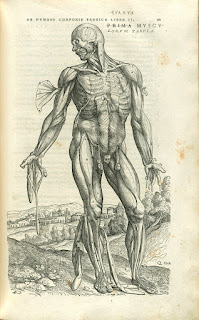Week 7: Neuroscience + Art
The brain is the most complex, and arguably the most important, of all the organs in our body. For something that plays a role in everything human beings do, there are still so many things that are unknown about the brain. However, in recent years, the field of neuroscience has been making advances on imaging and studying the brain and its functions. Because of the brain’s central role in daily life, it is not surprising that studying the brain has gone beyond the field of neuroscience to influence other parts of society, what Franzetto and Anker termed neuroculture.
 |
| Examples of the some of the many different shapes a neuron can have. |
What makes neuroscience and all things brain related so easy to apply to other areas is the vast amount of diversity within the brain. Not only are most of the neurons in the brain different, unique shapes but the brain performs so many function from controlling movement to pain awareness to consciousness.
The topic of consciousness could, in itself, be an entirely different field of study ranging into things like psychology, psyche, and morals. But, in regards to neuroscience, consciousness is viewed through the lens of the brain and the way it is responsible for our thoughts and actions. While some may think that our consciousness is fixed, that we are who we are, I disagree. I believe that all of our experiences and life events shape our consciousness and who we are, partly because I know these experiences change our brain. For instance, the brains of people who experience chronic pain are physiologically different from brains of people who don’t. Physical changes can also be seen in the brains of those with long term drug or alcohol use.
 |
| Shows various images made with Brainbow technique which paints neurons in different colors depending on activity level. |
Clearly our outside world is effecting what’s within us. I think that this is what makes the brain intriguing to artists. We can clearly see what our outside world is like but depicted the brain can give people a glimpse into what our internal world is like. This internal world can even be captured at different moments, as different parts of the brain are activated during different activities like listening to music versus sleeping versus reading. At Berkeley, scientists have even used brain imaging to recreate movies people where watching at the times the scans were done.
Sources:
Jung, Carl. “The Spiritual Problems of Modern Man.” n.p. Accessed 20 May, 2017.
Frazzetto, Giovanni, and Suzanne Anker. “Neuroculture.” Nature Reviews Neuroscience, vol. 10, no. 11, 2009, pp. 815–821., doi:10.1038/nrn2736.
“Brainbow.” Wikipedia, Wikimedia Foundation, 10 Apr. 2017, en.wikipedia.org/wiki/Brainbow. Accessed 21 May 2017.
Jabr, Ferris. “Know Your Neurons: How to Classify Different Types of Neurons in the Brain's Forest.” Scientific American Blog Network, 6 Aug. 2013, blogs.scientificamerican.com/brainwaves/know-your-neurons-classifying-the-many-types-of-cells-in-the-neuron-forest/. Accessed 21 May 2017.
Yasmin Anwar, Media Relations | September 22, 2011March 24, 2016, and Yasmin Anwar. “Scientists use brain imaging to reveal the movies in our mind.” Berkeley News, 24 Mar. 2016, news.berkeley.edu/2011/09/22/brain-movies/. Accessed 21 May 2017.


I really like how in your third paragraph, you introduced the belief about fixed conscious that some people have, but then disagreed to it and explained your own point of view. I feel like that is something that I could add to my blogs in order to make them more about my ideas, rather than simply eat others say
ReplyDeleteThis comment has been removed by the author.
DeleteI really enjoyed reading your blog. I think its very interesting and almost kind of creepy to study and learn about the conscious. I agree with you in that I believe that are past experiences and life events shape our consciousness.
ReplyDelete